A common thread ties together Joe Schmidt’s best moments in charge of Ireland. Australia’s new boss always had a knack for devising a single strike play to cut defences open.
Under Schmidt’s watch, 2018 was a golden year featuring an Irish Grand Slam coupled with a first home victory over the All Blacks. The title-winning St Patrick’s Day triumph over England gained momentum thanks to a CJ Stander try coming directly from deft midfield interplay between Bundee Aki and Tadhg Furlong.
Months later, Jacob Stockdale’s infamous chip and chase, leaving black jerseys in his wake, was set up by a midfield switch which exposed the New Zealand back field defence. On both occasions, Schmidt identified gaps and set up his players to expose them ruthlessly.

Is Joe Schmidt the right man for Australia?
Now, Ireland have a new set-play guru. Andrew Goodman’s reputation preceded him before he replaced Mike Catt on the coaching ticket. When previously working with Leinster, his clever lineout move allowed Dan Sheehan to score against La Rochelle in the 2023 Champions Cup final.
READ MORE
The French side went on to win the title, but Ronan O’Gara still gave his former Crusaders coaching colleague flowers for outsmarting him with that particular move.
Three games into his tenure, we are starting to see Ireland open up a new playbook under Goodman. The former centre did play under Schmidt when the two were at Leinster. Perhaps not enough to label Saturday’s showdown as ‘master vs apprentice’, but the two Kiwis share sufficient attacking expertise to whet the appetite even further on what is already a day of reunions.
Teams are always reluctant to show off their entire arsenal during Test match windows. Individual matchups may well lead to unique, one-off strike moves which are for this weekend’s eyes only. Regardless, we have seen enough from Ireland’s handful of games under Goodman to recognise how he spots an opposition weakness and sets about exploiting it.
Against New Zealand, Ireland’s set-piece malfunctioned to the point they had virtually no quality possession to launch. A week on, the Argentina match saw the Irish attack in the first half ruthlessly attack the ‘seam’ between the lineout and the backline, a gap necessitated by the 10 metre offside line. The second half was less effective. Come the Fiji game, Ireland’s first phase attack fired shots across the entire 80 minutes.
Caelan Doris’s fifth-minute try started at a lineout deep inside the Fijian 22. After launching a dummy maul, hooker Gus McCarthy came bounding around the corner only to pop the ball inside for his captain to crash over. If it looked familiar, it’s because Rónan Kelleher did something very similar against Argentina.
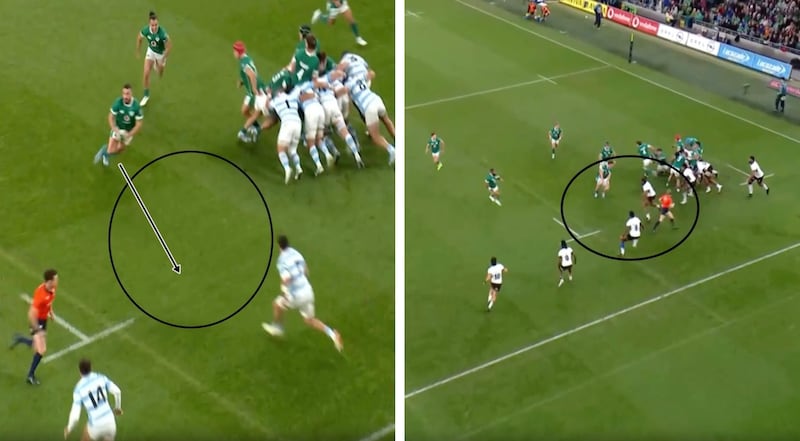
Only this time, Ireland added subtle variation. Against Argentina, all eight forwards were in the lineout. Los Pumas were ill-disciplined in keeping a body in that ‘seam’ between the back of the lineout and the backline. Kelleher saw the gap and came down with a dose of white line fever. He carried himself when an inside pass to the trailing James Lowe might have led to a score. As it happened, Crowley crossed seconds later.
A week on, swap out Kelleher for McCarthy and Argentina for Fiji. Ireland put seven forwards into the lineout, with Doris lurking in the backline. This time, when McCarthy leaves the maul, Fijian hooker Tevita Ikanivere is waiting for him as the tail gunner, the man marking the seam. Staring at a defender instead of into a 10m gap, McCarthy opts to pass. Doris runs the Lowe line, which this time is rewarded as Ireland barge their way over.
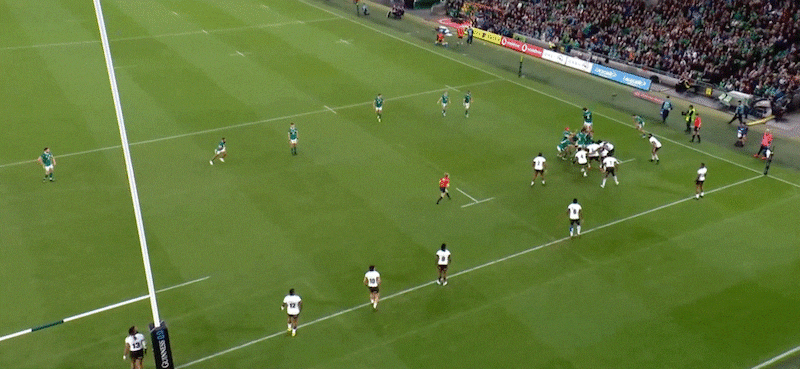
As well as these variations on a theme, Ireland displayed a ruthless ability to isolate individual defenders. Poor old Caleb Muntz and Waisea Nayacalevu – Fiji’s 10 and 13 – had a torrid day defending the midfield channel. Both men missed four tackles each. Bundee Aki (77) and Jacob Stockdale (70) had high metres-carried figures. Aki also led Ireland for line breaks (four), while Robbie Henshaw beat the most defenders (seven). All these stats are linked.
In the 50th minute, Ireland found a clever way of getting into Nayacalevu’s channel. Off a lineout, Aki took the ball at first receiver, as he often does. Outside him are the usual front door, back door passing options. Normally, the front door runner, in this case Doris, carries into contact. Only this time, the Ireland captain pulls off a late, deft pass behind, rather than across his body to find Sam Prendergast.
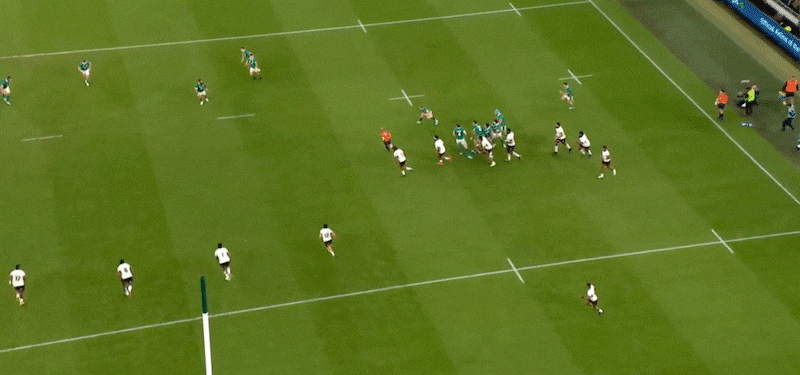
With Stockdale on the outhalf’s shoulder and Cian Prendergast running a hard inside line, Ireland flood the gap created by Nayacalevu disconnecting from his team-mates. He’s caught in no man’s land and Ireland pick him off, as they did many times on the day.
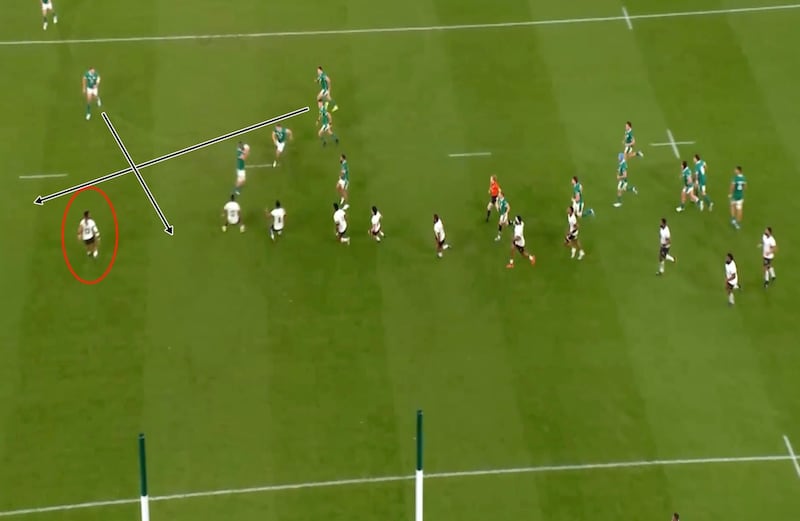
They also went after outhalf Muntz with a good, old fashioned crash ball. On 70 minutes, another Aki lineout carry sees him approach the gainline with passing options. The three defenders next to outhalf Muntz all commit to Aki’s outside shoulder.
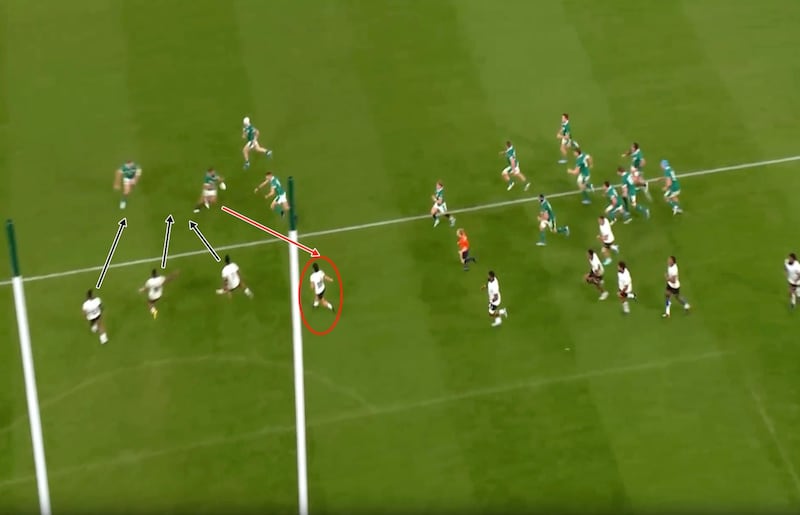
He sees this, takes a big step on his left and powers through a one-on-one tackle with an outmatched Muntz – who slips in any case from also committing too far in the wrong direction.
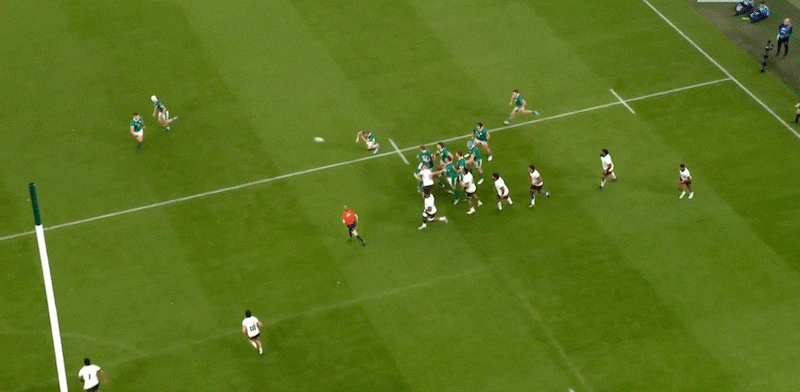
This is more likely a case of Aki’s individual reading of the game, rather than a coach’s instruction. But the success comes from allowing Aki to make that call within a system which had stretched Fiji’s outside defence all day long, forcing them into harmful muscle memory.
If I’ve spotted this, you can be damn sure Schmidt has too. Australia will be wary of how various Irish runners attack certain areas and individuals, making different decisions based on the defensive picture.
Ireland will also look at how other teams have attacked Australia. Their own midfield has shown cracks, with outhalf Noah Lolesio, centre Len Ikitau and new centre sensation Joseph Sua’ali’i all recording north of four missed tackles across this November campaign. Last weekend, Scotland exploited that midfield with a long lineout throw which allowed Sione Tuipulotu to crash over.
Not that Australia are without their own tricks. Harry Potter’s ‘magical’ try came straight from a lineout move which saw his hooker take a short throw into the heart of the set-piece.
Ireland fans might recognise this from when Scotland ran a similar move in their 2017 Six Nations victory at Murrayfield. Schmidt, in charge of a losing Irish side that day, used Scotland’s set-play against them seven years on at the scene of the original crime.
Joe never forgets.
Secrets are kept close to chests. The above clues cannot lead to certain predictions of what Ireland or Australia will throw at each other. What is certain, though, is that so long as the set-pieces behave, Goodman and Schmidt’s battle of set-play detail could become a defining subplot.
- Sign up for push alerts and have the best news, analysis and comment delivered directly to your phone
- Join The Irish Times on WhatsApp and stay up to date
- Listen to our Inside Politics podcast for the best political chat and analysis













